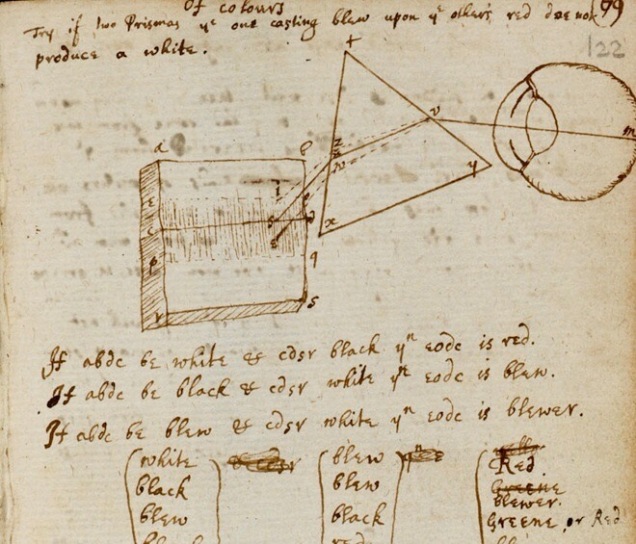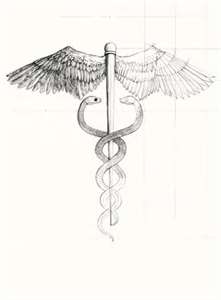This is on an old post but so great that I wanted to repost it.
“Arum Rae – Warranted Queen”
Issac Newton’s Person Notebooks Go Digital

THE LARGEST COLLECTION of Isaac Newton’s papers has gone digital, committing to open-access posterity the works of one of history’s greatest scientist.
Among the works shared online by the Cambridge Digital Library are Newton’s own annotated copy of Principia Mathematica and the ‘Waste Book,’ the notebook in which a young Newton worked out the principles of calculus.
Other of his myriad accomplishments include the laws of gravity and motion, a theory of light — pictured above are notes on optics — and his construction of the first reflecting telescope.
Newton was also notoriously idiosyncratic and irascible, obsessed with the occult and vicious towards scientific rivals; a full account of his life and science can be found in James Gleick’s Isaac Newton, and a partial but entertaining fictionalization in Neal Stephenson’s Baroque Cycle. But the papers come straight from the master.
“Anyone, wherever they are, can see at the click of a mouse how Newton worked and how he went about developing his theories and experiments,” said Grant Young, the library’s digitization manager, in a press release. “Before today, anyone who wanted to see these things had to come to Cambridge. Now we’re bringing Cambridge University Library to the world.”
Approximately 4,000 pages of material are available now, and thousands more will be uploaded in coming months. On the following pages is a sampling of the the library.
In Need of GPS
Warrented Queen
Spontaneous Photon Emission from Human Body
Imaging of Ultraweak Spontaneous Photon Emission from Human Body Displaying Diurnal Rhythm
The human body literally glimmers. The intensity of the light emitted by the body is 1000 times lower than the sensitivity of our naked eyes. Ultraweak photon emission is known as the energy released as light through the changes in energy metabolism. We successfully imaged the diurnal change of this ultraweak photon emission with an improved highly sensitive imaging system using cryogenic charge-coupled device (CCD) camera. We found that the human body directly and rhythmically emits light. The diurnal changes in photon emission might be linked to changes in energy metabolism.
“Human body is glimmering with light of intensity weaker than 1/1000 times the sensitivity of naked eyes.
The photon emission mechanism is thought to originate from the generation of free radicals in energy metabolic processes. The spectra of photon emission detected from the palm skin span from 500 to 700 nm, with primary and secondary emission peaks at 630–670 nm and 520–580 nm, respectively.
Free radicals subsequently react with lipid or protein, generating electronically excited species as byproducts.
These excited molecules, such as carbonyl group in excited triplet state from lipid peroxidation or proteins including excited tyrosine or tryptophan, can further react with fluorophores through energy transfer and lead to photon emission.
Recent advances of chronobiology have revealed that the redox state of the cells regulates circadian gene expression, indicating the importance of metabolic cues for clock oscillations.
Indeed, glucose utilization, accompanied by oxygen consumption, shows robust rhythms in the main mammalian circadian center.
By the regulation of cellular respiratory chain producing reactive oxygen species, which in turns react with molecules including proteins, lipids and fluorophores, whose excited states emit biophotons, the human body glitters to the rhythm of the circadian clock.”
“Today, our computers are far more advanced, and yet at the core, the electrical information we are passing through computers today is still a form of light. Now our sciences are revealing humans work the same way, and Light carries information through our brain, nervous system, and even our DNA.
If that wasn’t cool enough already, scientists have also discovered that not only do we emit light, we have the ability to effect it with our thoughts alone. In a recent study, participants were placed in a darkened room and asked to visualize a bright light. When they did this, they were able to increase their levels of biophoton emissions significantly, showing that our intentions have an influence on light itself!”
An introduction to human biophoton emission.
Biophoton emission. New evidence for coherence and DNA as source.

Find What You Love
Rumi
Tuning to the Infinite: The Conspirachi of Noncommutative Time-Frequency Consciousness

F.W. Schelling in 1809 wrote of the conspiracy of life and unity as a secret breathing exercise wherein the body takes up a strong internal heat, as the formless void is contemplated.
Interested? Click the link to read much more.
Tuning to the Infinite: The Conspirachi of Noncommutative Time-Frequency Consciousness
A B.B. King Classic
Now a little blues to wind down.











You must be logged in to post a comment.